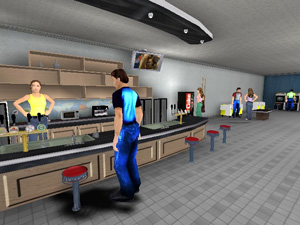|
|||
Interactive Storytelling: the Rise of a New Game Genre?by Marc Cavazza The development of computer games involves sophisticated programming techniques but has long been characterised by a marked preference for empirical solutions, when it came to supporting gameplay. This is best exemplified by considering the Artificial Intelligence (AI) problems most games' genres are faced with. In the early days of game development, 'AI' referred to all behavioural aspects, rather than to the techniques known to the academic world. This situation has evolved rapidly over the past few years. Several AI techniques are now used routinely in computer games. In addition, more people embrace the idea that the future of gaming, in particular the development of new genres and new interaction modalities will largely depend on AI techniques. Interactive Storytelling is probably the best illustration of an AI concept that would open the way for new games genre. The idea behind interactive storytelling is to reconcile narrativity with interaction. Films tell great stories, whose pace and suspense have been carefully authored; but it is impossible for the spectator to have any influence on the action. On the other hand, some computer games are highly interactive, and see much of the action being driven by the user. However, they lack the ability to organise their progression according to the narrative elements spectators have learned to recognise and enjoy. The technical solution to this problem consists in generating the story in real-time, which makes possible to propagate the consequences of user interaction, while retaining the overall logic of a baseline plot. Because at the most abstract level a story can be described as a sequence of actions, it will come as no surprise that Planning is the main AI technique supporting Interactive Storytelling systems. An interactive story presents itself as a real-time 3D animation featuring autonomous characters (see Figure). However, unlike with a traditional animation, the user is allowed to intervene in the story and modify its course.
Our group has been involved in Interactive Storytelling research for the past four years and has developed an approach known as character-based interactive storytelling. In this approach, the baseline story is decomposed into roles for each character. These roles are formalised as Hierarchical Task Networks (HTN), which are powered by a simplified HTN planning system. To turn a story into a narrative, the sequence of actions has to be properly staged: each terminal action executed by the planner actually controls a real-time animation. We have developed our system on top of a commercial game engine, Unreal Tournament 2003™, which provides sophisticated visualisation as well as an excellent development environment. We have developed several Interactive Storytelling prototypes, most of them inspired from the 'sitcom' genre. The rationale being that, besides altering the story ending, the generation of situation is an important validation for a research prototype. In these systems, we define several characters each having a specific role. In our latest system one character wants to organise a party, so the HTN corresponding to that role comprises various sub-tasks, such as finding the venue, inviting friends, finding drinks and food, etc. Her actions can however be contrasted by other characters which compete for the same resources (eg for other characters' attention, etc). Action failure produces situations that can be dramatised, while at the same time they drive the story to a different path. The user can interfere with the action either by physical intervention (eg removing certain objects from the set) or by talking to the characters. Using speech recognition, the spectator can formulate advice or information that will alter the characters' intentions or even the relationships between characters. Recently, we have explored scalability issues in Interactive Storytelling, which constitute a major limitation to the development of Interactive Storytelling into a usable technology. We have investigated the impact on the HTN size and on the number of characters on the overall story complexity, by measuring the number of situations generated, as well as the total narrative duration. At this stage, the system can operate in real-time a cast of up to eight characters and generate stories up to six minutes long. This measure of technical robustness does not incorporate any judgement of the artistic quality of the narrative so generated. This is why, at the current stage of this research, the average proportion of 'interesting' stories (as could be rated by a spectator) probably does not exceed 15%. However, this early stage is only devoted to developing a basic technology that would support experiments and the identification of aesthetic problems. Interactive Storytelling, as a long-term endeavour, is largely present in popular culture as being the future of entertainment, for instance through the Sci-Fi vision of the Holodeck™. Although the development of new media is always difficult to anticipate, the re-introduction of narrative and high-level interaction in gaming has a significant potential to develop next-generation entertainment technologies. This could even extend the population of gamers across gender and age barriers. Link: Please contact: |
|||



